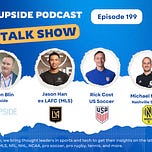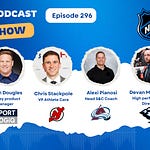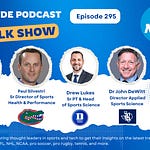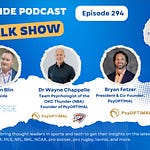This week we have the honor to interview again a group of sports performance executives to talk about the latest trends in the world of sports performance and rehabilitation.
Jason Han, the former head of rehabilitation at LAFC (MLS). Jason is also the head of business development in North America at OneBase health.
Michael Messer, the head of rehabilitation, Nashville SC (MLS).
Rick Cost, the High Performance Director at the US Soccer Federation.
📝Show Notes: Through this interview, we touched on:
How to tailor rehabilitation programs for different age groups (1st team, academy..).
The risks or limitations to relying heavily on technology in sports.
The role of biomechanics in identifying and improving athletic potential.
The next big technological leap in sports.
The biggest misconceptions about rehabilitation or sports performance.
How to balance pushing athletes to their limits while ensuring their long-term health.
You can read the full transcript of the podcast interview located at the top of this blog post.
Here are some of the best quotes of our conversation with Michael, Rick and Jason:
Q1. How do you tailor rehabilitation programs for different age groups (1st team, academy)?
Rick Cost:
"Rehabilitation isn't just about an age group; it's about the individual within that group. Every athlete has unique needs, even within similar categories like academy or first-team players. Resources also play a significant role—first-team environments often have access to advanced data, such as GPS or force plates, which allow for precise tailoring of rehab programs. In contrast, academy settings may require professionals to rely on observation and general programs due to limited resources. Tailoring rehab involves understanding the individual’s role in the team and balancing the needs of the athlete with the goals of the organization."Jason Han:
"When working with academy athletes, the emphasis is on building the fundamentals—educating them on biomechanics, fostering long-term development, and ensuring they grow into their bodies. It’s about creating a strong foundation for success as they advance. First-team players, however, are dealing with different challenges. They may have intense travel schedules, higher stress levels, and greater physical demands. For older athletes, recovery strategies become essential. It's not just about tailoring programs to the individual but also to the team’s dynamics and external factors like travel and competition schedules."Mike Messer:
"There’s often a higher risk tolerance with first-team players, especially if they’re in the playoffs or under contract. This is their livelihood, and sometimes the pressure to return quickly influences rehab decisions. Academy players don’t face the same immediate pressures, so rehab tends to be more cautious and developmental. It’s about balancing the urgency of the team’s needs with the athlete’s long-term health and career trajectory."
Q2. Are there any risks or limitations to relying heavily on technology in sports?
Rick Cost:
"We live in an era where technology is everywhere, but we often forget about the physiological limits imposed by nature. Technology provides data, but without proper context or understanding, it can lead to conclusions that are irrational or ineffective. For example, spending on advanced recovery modalities may provide minimal actual benefits compared to simpler, proven methods. The key is to critically evaluate what each tool does, its cost, and how it fits into the overall picture of performance and recovery. Blindly adopting technology without considering its impact can do more harm than good."Jason Han:
"While technology can enhance decision-making and provide valuable insights, it must be paired with the human element to be effective. For instance, sleep data might suggest an issue, but a conversation with the player could reveal personal factors affecting their recovery, like family stress. Ultimately, technology is a tool, not a replacement for the nuanced understanding that comes from human interaction and expertise. A cohesive team that integrates data with real-world insights and player relationships creates the most effective environment."Mike Messer:
"One of the most significant risks of using technology is blindly accepting what it tells you without truly understanding it. If you don’t know the nuances of the tools you’re using, you might misinterpret the data or make flawed decisions. You don’t need to be an expert in every detail, but a foundational understanding of the technology is critical to avoid potential pitfalls and maximize its benefits."
Q3. Can you discuss the role of biomechanics in identifying and improving athletic potential?
Rick Cost:
"Biomechanics is such a fascinating but under-standardized field. Everyone has a different approach to understanding movement, but what’s missing is a common language or framework. Ideally, biomechanics should aim to make movement more efficient and safe for athletes, reducing energy expenditure and injury risk. For example, something as simple as the ideal foot placement during a change of direction can drastically affect performance and safety. However, without agreed-upon best practices, we’re often relying on opinions and experience rather than consistent, validated methods."Jason Han:
"Early in my career, I believed there was a ‘perfect’ way to move—like a squat or a split squat had to look a certain way, or the athlete was at risk of injury. But over time, working with high-level athletes, I’ve seen individuals who defy those norms and still perform exceptionally well. It’s about blending performance goals with injury prevention and recognizing that what’s ‘perfect’ might vary from athlete to athlete. Biomechanics should guide improvements, not force a rigid model."Mike Messer:
"It’s challenging to tell an elite athlete they’re moving incorrectly, especially when they’re performing well and making millions. Instead of trying to ‘fix’ their movement, the focus should be on enhancing what they already do well while mitigating injury risks. Biomechanics is a gray area, and while we all agree there might be an ideal way to move, we don’t yet have the tools or systems to identify and implement it consistently."
Q4. What do you think the next big technological leap in sports will be?
Rick Cost:
"The future of sports tech lies in low-burden, high-impact solutions. AI-based decision-making tools that synthesize data and provide actionable insights will revolutionize the field. Imagine systems that predict optimal recovery protocols or ideal movement patterns in real time. The challenge is ensuring that these solutions are practical and don’t add unnecessary complexity or cost to already overburdened systems."Jason Han:
"For me, recovery-focused technology, like hyperbarics or photobiomodulation, holds enormous potential. At LAFC, we introduced hyperbaric therapy to enhance recovery for high-profile players, and while it was part of a broader strategy, it made a noticeable difference. The challenge isn’t just developing the technology but also educating athletes about its value and integrating it seamlessly into their routines."Mike Messer:
"From a practitioner’s perspective, consolidating technology would be a game-changer. Imagine a jersey that functions as a GPS tracker, heart rate monitor, and sweat analyzer—all in one. Additionally, advancements in neurocognitive technology, focusing on the brain’s role in sports performance, could open entirely new avenues for training and rehabilitation."
Q5. What do you see as the biggest misconceptions about rehabilitation or sports performance?
Rick Cost:
"A big misconception is that doing more will speed up recovery. In reality, the body has physiological limits set by nature. Effective rehabilitation isn’t about rushing the process; it’s about guiding the athlete efficiently through each stage of recovery. Mistakes in this process, such as pushing too hard too soon, can lead to setbacks and re-injury."Jason Han:
"Rehab and sports performance are deeply connected. Good rehab doesn’t just fix an injury—it addresses the underlying causes and ensures the athlete returns stronger and more resilient. Bridging the gap between injury recovery and functional performance is a critical part of the process."Mike Messer:
"Rehabilitation and performance are often seen as separate, but they’re intertwined. To get an athlete back to peak performance, you need to understand what that performance looks like and reverse-engineer the process. Collaboration across disciplines is essential to achieving the best outcomes."
Q6. How do you balance pushing athletes to their limits while ensuring their long-term health?
Rick Cost:
"As practitioners, we’re the advocates for the athlete. Coaches may push for quick returns, but it’s our responsibility to prioritize the athlete’s long-term health. Strong communication, both with the athlete and the coaching staff, is critical. Asking meaningful questions like, ‘How are you feeling today?’ and truly listening to the answers helps build trust and guide decisions that balance performance with safety."Jason Han:
"Communication is everything. Athletes need to feel heard, and practitioners need to listen more than they talk. Building relationships through everyday interactions—not just discussing injuries—helps you understand the athlete on a deeper level and make informed decisions about their limits and well-being."Mike Messer:
"If there’s a conflict between test results and what the athlete is telling us, we prioritize the athlete’s perspective. No data point outweighs the importance of open communication and mutual understanding. It’s about creating a balance that pushes athletes toward their goals without jeopardizing their health."
You may also like:
🔥Upside Chat with Sports Rehab Execs: Chris Wolbert (Sporting KC / MLS), Jason Han (Ex LAFC / MLS), Mike Messer (Nashville SC / MLS)
This week we have the honor to interview again a group of MLS rehab executives:
🔥Upside Chat with Derek Lawrance (USMNT), Jason Han (LAFC/MLS), Athanase Kollias (KINVENT), Quin Sandler (Plantiga) on Athletes' Rehab and Return to Play
This week we had the honor to interview again a group of sports performance experts.













